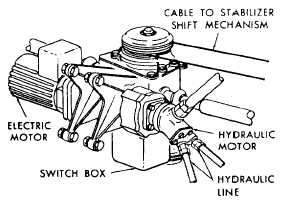fluid overboard. The leading edge flaps extend to the
full down position and trailing edge flaps to the 1/2
down position. The aileron drooping feature does not
operate when the flaps are lowered by the emergency
flap system.
SEMI-INDEPENDENT FLAP AND SLAT
SYSTEM
This system consists of semi-independent flap
and slat systems, which raise and lower using
hydraulic motors drive units, torque tubes, and screw
jack-type actuators.
Flap System
The flaps divide into two panels per wing at the
wing-fold joint. Each panel is supported by two sets
of tracks and rollers that are driven by two ball screw
actuators.
Pressure from the combined hydraulic
system powers the flap drive motor and gearbox
assembly, shown in figure 9-35.
If the combined hydraulic system fails, a
hydraulic brake locks the hydraulic motor, and an
emergency electric motor provides continued
operation. Emergency flap extension and retraction is
controlled by placing the EMERG FLAP switch on
the throttle quadrant at either UP or DN.
Cam-operated switches within the flap drive gearbox
provide input signals to show the flap position on the
cockpit-integrated position indicator.
Operation of the flap control handle energizes the
solenoid-operated flap selector valve, directing
hydraulic pressure to the extend or retract lines of the
flap drive motor.
The wings must be spread and
locked to provide a complete electrical circuit through
the wing unlock relay to the selector valve.
Figure 9-35.—Flap drive gearbox.
Placing the flap control handle to the TAKEOFF
position completes the electrical circuit through the
30-degree switch and cam-operated flap drive
gearbox limit switch to the selector valve. Pressure
ports to the down side of the high-speed hydraulic
motor, which drives the gearbox.
The flap drive
gearbox, through a series of torque tubes and offset
gearboxes, drives all eight flap actuators.
The flap actuators, shown in figure 9-34, drive the
carriage and attaching flaps out and down to the
30-degree position. The limit switch in the flap drive
gearbox opens, de-energizing the selector valve
circuit, allowing the valve shuttle to return to neutral,
blocking flow to the motor, and preventing further
flap extension.
Placing the flap control handle to LAND
mechanically closes the 40-degree down flap handle
switch. The electrical circuit to the selector valve
completes, this time through the now closed
40-degree down limit switch in the flap drive gearbox.
The flaps will extend to 40 degrees, and the electrical
circuit will be broken by the action of the limit switch.
Moving the flap control handle to the TAKEOFF
or UP position will energize the opposite solenoid of
the flap selector valve and port pressure to the retract
side of the flap hydraulic motor. If the TAKEOFF
position is selected, a limit switch will again halt flap
movement at the 30-degree position. If UP is
selected, retraction will be halted when the flaps reach
the full up position. Stopping the flaps is a function
of the flaps up limit switch. At the same time, linkage
from the up limit switch actuates a second switch to
complete the electrical circuit to the flap hydraulic
motor brake valve. The energized valve blocks
combined hydraulic system pressure that is holding
the hydraulic brake in the unlocked position. The
brake locks the hydraulic motor, which, in turn, locks
the flaps in the up position.
If combined hydraulic system pressure fails and
the emergency flap switch is used, the flap action is
powered by the electric motor. See figure 9-35. The
flap hydraulic brake valve is energized, and the
pressure holding the spring-loaded hydraulic motor
brake unlocked will port to return. The brake is then
free to lock the motor and input shaft.
The electric motor now drives the flap gearbox
and associated linkage, bypassing the locked
hydraulic motor.
This action occurs until the flaps
reach a 40-degree trailing edge down position. Limit
9-42


